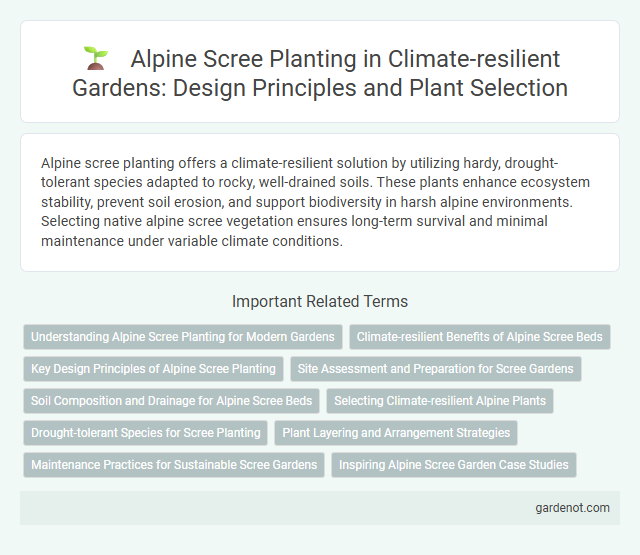Alpine scree planting offers a climate-resilient solution by utilizing hardy, drought-tolerant species adapted to rocky, well-drained soils. These plants enhance ecosystem stability, prevent soil erosion, and support biodiversity in harsh alpine environments. Selecting native alpine scree vegetation ensures long-term survival and minimal maintenance under variable climate conditions.
Understanding Alpine Scree Planting for Modern Gardens
Alpine scree planting involves selecting hardy, drought-tolerant species that thrive in rocky, well-drained soils mimicking natural mountain conditions. Plants like Saxifraga, Sedum, and dwarf conifers adapt efficiently to temperature fluctuations and low nutrient availability, making them ideal for climate-resilient gardens. Incorporating alpine scree plants enhances biodiversity while reducing water use and maintenance in modern landscaping.
Climate-resilient Benefits of Alpine Scree Beds
Alpine scree beds provide climate-resilient benefits by supporting plant species adapted to extreme temperature fluctuations and poor soil conditions, enhancing biodiversity in vulnerable mountainous regions. These beds improve soil stability and water retention, mitigating erosion and aiding in climate change adaptation. Their unique microhabitats foster drought-resistant vegetation, promoting ecosystem resilience under shifting climate patterns.
Key Design Principles of Alpine Scree Planting
Alpine scree planting relies on key design principles such as selecting drought-tolerant and cold-hardy species adapted to high-altitude, nutrient-poor conditions. Emphasizing rock placement to mimic natural scree slopes improves drainage and root stability, promoting plant resilience. Incorporating species diversity enhances ecosystem stability by supporting soil retention and microhabitats essential for long-term climate adaptation.
Site Assessment and Preparation for Scree Gardens
Site assessment for alpine scree planting involves analyzing soil composition, drainage capacity, and microclimate conditions to ensure suitability for drought-resistant, cold-hardy species. Preparation includes creating well-drained, rocky substrates that mimic natural scree environments, incorporating coarse gravel and sand to facilitate root aeration and water runoff. Proper site selection and substrate engineering enhance plant establishment and long-term resilience against climate stresses in scree gardens.
Soil Composition and Drainage for Alpine Scree Beds
Alpine scree beds require well-drained, coarse-textured soil composed of grit, sand, and small stones to replicate natural mountainous conditions and prevent waterlogging. The soil must be low in organic matter to mimic the nutrient-poor environment typical of alpine scree habitats, promoting the growth of specialized, drought-tolerant plants. Effective drainage is crucial to avoid root rot and ensure survival of cold-hardy alpine species adapted to rapid water runoff and minimal moisture retention.
Selecting Climate-resilient Alpine Plants
Selecting climate-resilient alpine plants for scree planting focuses on species adapted to extreme temperature fluctuations, drought, and poor soil conditions typical of high altitudes. Plants such as Saxifraga, Silene, and Sedum exhibit strong drought tolerance, deep root systems, and ability to thrive in rocky substrates, making them ideal for climate-resilient scree gardens. Prioritizing native alpine species with proven resilience enhances ecosystem stability and supports biodiversity in mountainous regions facing climate change impacts.
Drought-tolerant Species for Scree Planting
Drought-tolerant species such as Sedum, Saxifraga, and Sempervivum thrive in alpine scree environments due to their ability to store water and endure prolonged dry conditions. These plants exhibit deep root systems and succulent leaves, optimizing moisture retention and ensuring survival on rocky, nutrient-poor substrates. Incorporating these species in scree planting enhances climate resilience by stabilizing soil and maintaining biodiversity under increasing drought stress.
Plant Layering and Arrangement Strategies
Alpine scree planting employs plant layering and arrangement strategies to enhance climate resilience by mimicking natural vegetation patterns that optimize microclimates and soil stability. Selecting drought-tolerant ground covers combined with mid-height shrubs and taller alpine perennials creates diverse canopy structures, improving moisture retention and reducing erosion. Strategic spatial placement maximizes sunlight exposure and wind protection, fostering robust growth in harsh alpine environments.
Maintenance Practices for Sustainable Scree Gardens
Regular inspection of drainage systems in alpine scree gardens is essential to prevent waterlogging and promote healthy root growth. Employing seasonal pruning and removal of dead plant material minimizes disease risk and enhances air circulation among scree plants. Applying organic mulch tailored for alpine conditions retains soil moisture and suppresses weed growth, supporting sustainable scree garden maintenance.
Inspiring Alpine Scree Garden Case Studies
Alpine scree planting showcases resilient vegetation thriving in rocky, nutrient-poor substrates, exemplified by case studies such as the Swiss Alps' Schynige Platte garden, where native saxifrages and sedums stabilize soil and enhance biodiversity. These gardens demonstrate innovative techniques like microtopography creation and drought-tolerant species selection to combat erosion and climate variability. Inspiring examples emphasize the integration of ecological principles and aesthetic design, proving scalable models for climate-resilient alpine gardens worldwide.
Alpine scree planting Infographic

 gardenot.com
gardenot.com